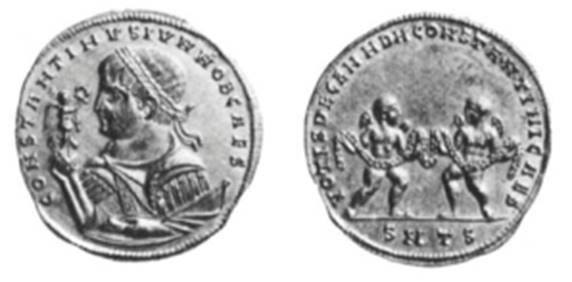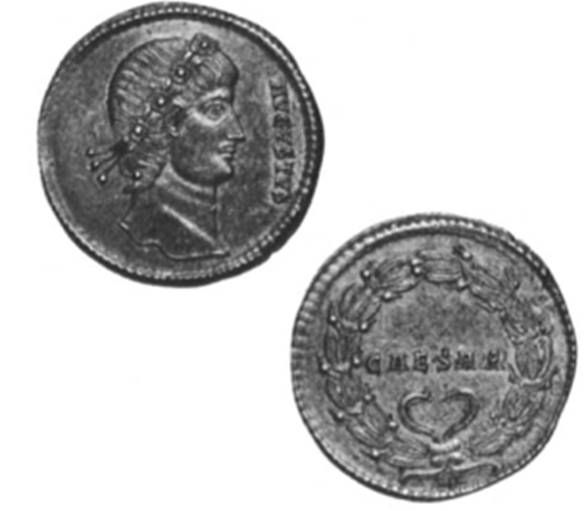Medallion of Constantine II. Thessalonike, 326. Gold. Medallion of Constantine I
obv: const antinvs INV(ior) NOB(ilissimus) CAES(ar). Bust of Constantine II facing left, laureate, in cuirass and paludamentum holding in right hand globe surmounted by Victory and in left hand the head of an eagle-tipped scepter or sword (?).
rev: votis DECENN(alibus) D(omini) N(ostri) con- stantini CAES(aris). Two genii facing each other holding a garland of flowers. In exergue, SMTS (Sacra Moneta Thessalonicensis)

Toynbee (1944, p. 171) has pointed out that Constantinian medallions gradually abandon the “plastic" in favor of the “engraving," or linear, technique, of which these two medallions are good examples; both illustrate the tendency toward broader, thinner flans, which began in the East but quickly spread throughout the empire.
Despite their identity of type and similarity of technique, the portraits show that the general rule of increasingly uniform style throughout the empire cannot be applied in all cases. The portrait of Constantine, though linear, is not schematic; the focus on the eyes and the substitution of diadem for laurel wreath look forward to the Hellenistic revival of the later Constantinian period. The tortured posture of Constantine II, with limbs contorted and the garb and attributes perfunctorily rendered, stands in sharp contrast.
The two pieces help to date one another. The Constantinian medallion, with its vague celebration of the "joy of our Augustus," was once associated with the consecration of Constantinople in 330; but the identity of reverse type shows that it belongs with the Thessalonican medallion of Constantine II, struck in 326 to celebrate his decennalia.
No. 35 was found at Alexandria in 1942 with no. 33 and a third medallion of Delmatius Caesar.
Formerly in the Pierpont Morgan collection. Bibliography: Gnecchi, 1912, I, p. 26, no. 21; Bellinger, 1958, nos. 6, 19.
Medallion of Constantine I. Siscia, Yugoslavia, 336 Silver. obv : avgvstvs. Head of Constantine facing right wearing diadem of jewels surrounded by squares of pearls separated by laurel leaves. rev: caesar within a wreath; beneath, sis(cia)

In later Constantinian art, forms became firmer and reproduction of physical features less precise; consequently, it is often difficult to identify portraits with specific members of the imperial house. The problem is even more complex in the case of this medallion, since it clearly derives from an Eastern coin of the first Augustus (27 b.c.-a.d. 14), of identical type with the legends reversed.
On the basis of similar medallions with caesar on the obverse and xx on the reverse, Lafaurie (1949) has suggested that the medallion portrays Constantine and that it was issued in 336 in connection with the vicennalia of his son Constantine II. This theory is consistent with the dates of operation of the mints that struck this issue and gains support from the frequent use of wreaths surrounding vota legends.
Formerly in the Hayford Peirce collection.
Date added: 2025-07-10; views: 160;
